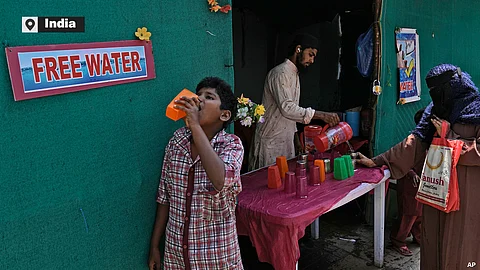
- Topics
- Feature
- Opportunities & Events
- About
- Hindi Portal
- Data
- Topics
- Feature
- Opportunities & Events
- About
- Hindi Portal
- Data

The other day in Greater Noida, after visiting a friend at the hospital, I stopped at a roadside stall for a glass of sugarcane juice. As I stood sipping in the shade on a hot summer day, a woman approached the vendor, asking for some water or ice. He gestured toward a nearby shop selling bottled water. It seemed as though she had been walking under the sun for a while and could not afford to purchase packaged water. She paused, pulled out an empty bottle, and politely asked if he could just refill it. He declined. She walked away, her thirst unquenched. The scene stirred something in me.
That small moment stayed with me. It reminded me of a different time—of growing up in Agra, where the sight of Piaos was common especially during the harsh summer season. These were small, community-run water stalls offering free drinking water to anyone passing by. Set up outside homes, temples, and along dusty roads, Piaos were symbols of kindness and community spirit. Wealthy families of societies would set up huge piaos at the heart of the society with clean water stored in huge clay pots to provide cool drinking water for free of cost to anybody who wanted a sip under the scorching heat of the sun during the day. But today, they’ve nearly disappeared.
Piaos were rooted in the values of sewa (service) and daana (charity). Set up under trees, near temples, or along roadsides, they provided respite for farmers, labourers, travellers, pilgrims, and daily commuters — particularly those from marginalised communities. In regions where temperatures often exceed 45°C (113°F), access to drinking water is not just a comfort but a survival need. I can hardly recall seeing any in recent years, even in my hometown, as they seem to fade away under the pressures of urbanisation and shifting social norms.
As North India faces longer, harsher summers with heatwaves becoming more frequent and severe, the disappearance of Piaos is not just a cultural loss — it’s a humanitarian one. The India Meteorological Department (IMD) has predicted nearly double the usual number of heatwave days in Northwest India this year, with temperatures expected to soar on 10 to 12 days, compared to the typical 5 to 6 days per season (Hindustan Times , 2025). This dramatic increase in heatwave days will undoubtedly worsen the conditions, intensifying the urgent need for accessible water, especially for passers-by and travellers enduring such extreme weather.
With increasing urbanisation and changes in lifestyles, people might rely more on purchasing bottled water or accessing water through their workplaces or homes rather than seeking a drink of water from the public stalls. The practical challenges posed by increasingly severe heatwaves, evolving societal norms, and lack of municipal support might have contributed to a perceived decrease in the visibility or utilization of "piaos" during these times.
Today, climate change is accelerating the crisis. According to the Indian Meteorological Department, India recorded a 50% increase in heatwave days over the past decade. The Intergovernmental Panel on Climate Change (IPCC) predicts that heat-related mortality will rise steeply if access to water and cooling resources is not expanded. Amid this, water has become increasingly commercialised — with bottled water priced at ₹20–₹30 per litre. For daily wage workers, street vendors, rickshaw pullers, job seekers, and more, affording this several times a day is near impossible.
Health experts recommend an individual drink 3 to 5 liters of water per day in extreme heat. For those on foot, especially the poor and marginalized, carrying that much water is impractical and exhausting. With public water points disappearing and Piaos vanishing, they are left exposed — parched under a merciless sun, with limited means to hydrate.
This is the cost of commodifying a basic human right. The shift from freely shared water to profit-driven models reflects a societal move from community-centred care to individualised survival. What was once a collective responsibility has now become a personal burden — borne disproportionately by the poor.
Reviving the tradition of piaos will require a collective effort from both communities and government bodies. Government institutions can play a crucial role in reintroducing piaos as a low-cost, sustainable solution to water scarcity, especially during extreme heat. Local municipal bodies can identify high-footfall areas, such as bus stations, market areas, or public parks, to set up piao stations. These can be stocked with clean water in large, durable containers, such as earthen pots or steel drums, and refilled regularly from municipal water supplies.
Government bodies can collaborate with local businesses, NGOs, or community groups to maintain these stations, ensuring proper hygiene and accessibility. By incorporating piaos into urban planning and climate resilience strategies, the government can create a network of water stations that serve both the environmental and social need of communities, particularly during peak summer months.
Reimagining piaos isn’t just about infrastructure—it’s about values. It's about choosing empathy over indifference, community care over individual convenience. A humble pot of water on a street corner could be a lifeline, a message: you are seen, your thirst matters.
As climate change challenges our resilience, perhaps it’s time to revive an old wisdom: that in sharing water, we share humanity.
Marcelina Kujur works with WaterAid India in Delhi. The opinion expressed here is her own.